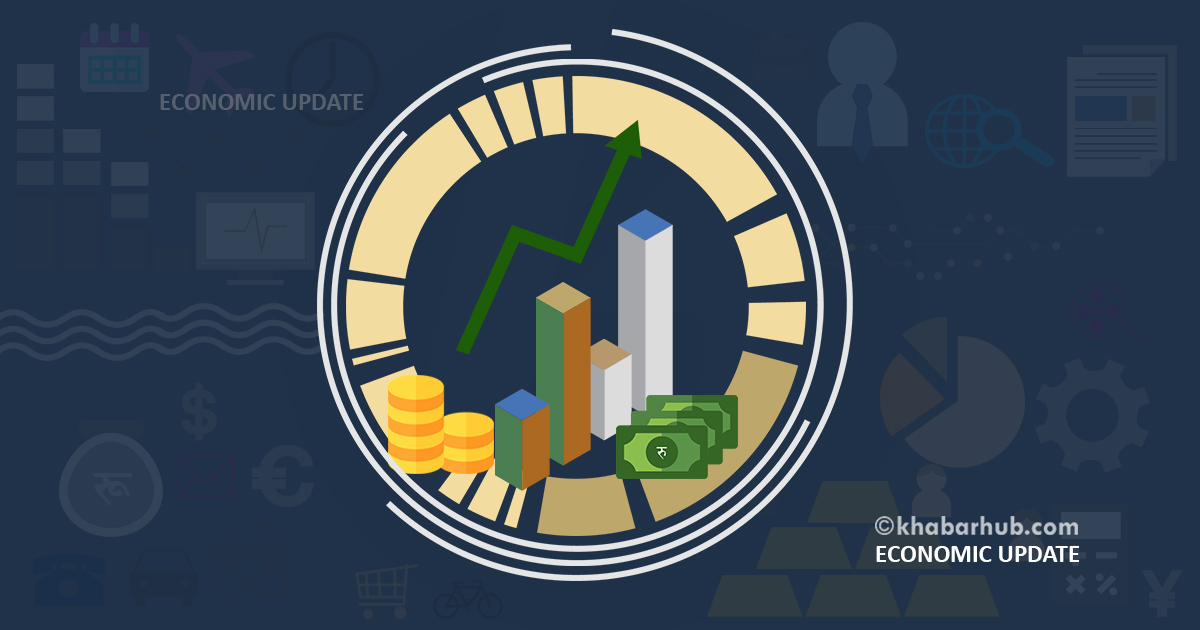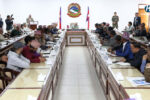KATHMANDU:
The monthly Economic Digest delves into Nepal’s dynamic financial landscape amidst regulatory shifts, gold market volatility, and fiscal challenges. The Nepal Stock Exchange (NEPSE) encountered a month of highs and lows, influenced by regulatory adjustments and global uncertainties. Initial optimism propelled the index to peaks above 2,030 points, driven by robust investor sentiment and capital influxes.
However, regulatory changes and fluctuating interest rates later introduced volatility, tempering gains across sectors.
Concurrently, Nepal’s gold market mirrored global economic forces, experiencing surges to record highs followed by corrections amid investor profit-taking.
As Nepal navigates these economic currents, attention turns to fiscal challenges highlighted by significant government arrears and strategic fiscal planning, underscored by the unveiling of a Rs. 1.86 trillion budget.
These developments underscore the imperative for vigilant monitoring and strategic foresight amid Nepal’s evolving economic landscape.
To begin with, the Nepal Stock Exchange (NEPSE) last month experienced a volatile month characterized by regulatory adjustments and global economic uncertainties.
The month began on a positive note with NEPSE showing robust gains, driven by investor optimism and substantial capital inflows. This bullish momentum saw the index reaching highs above 2,030 points, reflecting strong market sentiment.
However, the latter half of the month painted a more nuanced picture as the index navigated through volatility.
Despite intermittent gains, particularly in sectors like life insurance and tourism, NEPSE faced challenges. Regulatory changes impacting broker commissions and fluctuating bank interest rates contributed to sporadic declines in the index.
These factors underscored the market’s sensitivity to economic indicators and investor sentiment.
By the end of the month, NEPSE closed with cautious optimism. The month highlighted the importance of investors maintaining vigilance and strategic positioning.
It emphasized the need for monitoring both domestic economic indicators and global market developments to navigate Nepal’s evolving stock market landscape.
The breakdown of these arrears reveals a complex landscape of financial liabilities. Federal government offices are accountable for Rs 342 billion, while provincial and local government offices owe Rs 28.46 billion and Rs 193 billion, respectively.
Meanwhile, Nepal’s gold market experienced significant volatility driven by global economic forces and investor sentiment.
The month began with a bullish surge as economic uncertainties and geopolitical tensions increased gold’s appeal as a safe-haven asset.
This initial optimism pushed prices to record highs, with gold peaking at Rs 142,200 per tola on several occasions.
However, this period of peak prices was short-lived, followed by corrections and declines in subsequent weeks.
The market exhibited rapid adjustments with daily price fluctuations in response to changing economic indicators and geopolitical developments. Notably, profit-taking by investors amidst heightened market volatility led to declines following the peak prices.
Local market dynamics also influenced gold prices, albeit with variations. The Federation of Nepal Gold and Silver Dealers’ Associations noted shifts in local demand as prices escalated, suggesting that price elasticity influenced consumer behavior.
Throughout the month, investor sentiment remained a critical driver of market movements. It oscillated between cautious optimism driven by potential economic recovery and heightened anxiety due to geopolitical tensions or central bank policy decisions.
Looking ahead, the outlook for Nepal’s gold market remains uncertain yet cautiously optimistic. Factors such as inflationary pressures, central bank policies, and global geopolitical tensions will continue to influence gold prices.
Investors are advised to closely monitor economic indicators and global developments to seize opportunities and navigate market volatility effectively.
Likewise, the Nepal Planning Commission unveiled the estimated cost of approximately Rs 11.1 trillion for executing the 16th Plan, emphasizing the crucial role of private sector partnerships in funding its implementation. Dr. Min Bahadur Shrestha, Vice Chairman of the NPC, provided insights into the plan’s details, highlighting the need to exceed the Rs 11.1 trillion mark to fulfill its objectives.
The primary focus of the 16th Plan is to address structural barriers across various developmental aspects to enhance production, productivity, and competitiveness. This includes reforms and investments aimed at improving infrastructure, promoting innovation, and fostering sustainable economic growth.
The emphasis on private sector involvement underscores the government’s recognition of the sector’s pivotal role in driving economic development. Strengthening ties with the private sector is crucial not only for financing but also for leveraging expertise and resources to achieve the plan’s ambitious targets.
In another development, in its third-quarter review of monetary policy, the Nepal Rastra Bank (NRB) opted to maintain stability amidst evolving economic challenges. The review highlighted several key economic indicators and policy decisions shaping the country’s financial landscape.
One significant aspect of the review was the stability in key interest rates and liquidity management measures. Despite economic uncertainties, the NRB kept key rates unchanged while focusing on effective liquidity management through measures like the introduction of a fixed deposit facility.
The review also addressed challenges in the banking sector, including provisions to strengthen capital bases and manage risks effectively. Adjustments in risk weights and loan loss provisions were introduced to enhance financial sector resilience and stability.
However, the NRB’s stance on share margin financing remained cautious, reflecting its approach to managing risks associated with share-backed loans amidst fluctuating market conditions.
Overall, the monetary policy review underscored the NRB’s commitment to maintaining stability and fostering resilience in Nepal’s financial system. It balanced cautious optimism with proactive measures to address emerging economic challenges and support sustainable economic growth.
Additionally, Nepal achieved a significant milestone with its foreign exchange reserves reaching a record 19 trillion 11.86 billion rupees. This marked a notable 24.2 percent increase, driven by rising remittance inflows and a decline in imports.
The consistent growth in reserves reflects Nepal’s robust external sector performance and effective economic policies aimed at bolstering foreign exchange earnings.
Remittances from Nepalese working abroad played a crucial role in maintaining strong foreign currency inflows, highlighting their importance as a key component of the country’s external earnings.
The increase in reserves from their level in June 2018 underscores the effectiveness of Nepal’s economic policies over recent years. It signals the country’s improved economic stability and resilience in the face of global economic uncertainties.
Nepal Rastra Bank Governor Mahaprasad Adhikari emphasized the strength of the external sector and the availability of liquidity for economic initiatives.
The record-setting reserves position Nepal favorably in terms of economic stability and growth potential, providing a buffer against external shocks and supporting future development initiatives.
The Office of the Auditor General (OAG) recently reported a concerning surge in government arrears, totaling over Rs 1.18 trillion. This significant amount includes debts owed by federal, provincial, and local government offices, as well as institutional corporations.
The findings were part of the OAG’s 61st annual report, which highlighted fiscal challenges stemming from delayed payments and unresolved financial obligations across various government entities.
Bagmati Province’s leading position underscores its economic dominance, likely fueled by its capital, Kathmandu, which serves as Nepal’s political, cultural, and economic hub. In contrast, Karnali Province’s limited share highlights persistent challenges in economic development, exacerbated by geographical remoteness, infrastructural deficiencies, and socio-economic disparities.
In the fiscal year 2079/80 alone, arrears amounted to Rs 236 billion, underscoring the scale of financial mismanagement and the urgent need for improved accountability and financial discipline at all levels of governance.
The breakdown of these arrears reveals a complex landscape of financial liabilities. Federal government offices are accountable for Rs 342 billion, while provincial and local government offices owe Rs 28.46 billion and Rs 193 billion, respectively.
These figures encompass a range of commitments, from auditing and revenue dues to outstanding balances after settling foreign grants and loans, collectively amounting to Rs 513 billion.
The cumulative arrears highlight systemic challenges in financial planning, execution, and oversight across Nepal’s governmental structures, necessitating comprehensive reforms to enhance transparency and efficiency.
Amidst these fiscal challenges, the government has projected a modest economic growth rate of 3.9% for the current fiscal year, as presented by Finance Minister Barsaman Pun in the Economic Survey and Annual Review of Public Institutions.
This forecast, however, faces skepticism from political opposition amidst ongoing debates over economic policies and growth strategies. The projections include expectations of a 3.8% increase in total investment, aiming to bolster economic output and improve per capita income to $1,456.
The government also noted a 6.08% inflation rate and a 6.9% rise in revenue collection, indicating cautious optimism about economic recovery despite the prevailing fiscal constraints and arrears.
Simultaneously, investors in Nepal have engaged with the government to advocate for changes in tax policy, particularly seeking a reduction in capital gains tax rates.
This initiative reflects the investment community’s proactive stance in shaping fiscal policies to align with market dynamics and investor interests. Lowering capital gains taxes is seen as a potential catalyst for stimulating investment activity, enhancing market liquidity, and ultimately contributing to economic growth.
The proposed amendments aim to simplify tax structures and boost government revenue, highlighting the interconnectedness between fiscal policies, investor sentiment, and economic outcomes.
In response to economic conditions, Nepal’s commercial banks lowered their base interest rates to as low as 7%, responding to sluggish loan demand and excess liquidity.
This strategic adjustment seeks to stimulate borrowing activities and support economic expansion by making credit more accessible and affordable. The reduction in base rates, coupled with declining lending rates across major banks, underscores efforts to align financial policies with economic recovery objectives amidst evolving market dynamics.
However, Nepal’s public debt has concurrently escalated to nearly Rs 2.4 trillion, marking a Rs 98 billion increase in the last ten months alone. This surge, fueled by both domestic and international borrowing, presents a critical fiscal challenge that necessitates prudent debt management strategies and fiscal reforms.
The debt now represents 42.02% of the GDP, comprising internal and foreign components, highlighting the imperative for sustainable fiscal practices and strategic investments to mitigate long-term financial risks.
The provincial GDP trends in Nepal for the fiscal year 2080/81 BS reveal stark economic disparities across different regions, with Bagmati Province emerging as the frontrunner in GDP contribution at 36.4%, followed by Koshi at 15.8%, Lumbini at 14.3%, Madhesh at 13.1%, Gandaki at 9.1%, Sudurpaschim at 7.1%, and Karnali Province lagging behind with the smallest share at 4.3%.
These estimates reflect minor fluctuations compared to the previous fiscal year, with some provinces experiencing marginal declines while others see modest increases.
This move not only meets domestic energy needs but also contributes to regional energy security and economic advancement through energy trade. Such initiatives underscore Nepal’s commitment to sustainable energy development and harnessing natural assets for mutual benefits, while positioning the country as a key player in regional energy cooperation.
Bagmati Province’s leading position underscores its economic dominance, likely fueled by its capital, Kathmandu, which serves as Nepal’s political, cultural, and economic hub. In contrast, Karnali Province’s limited share highlights persistent challenges in economic development, exacerbated by geographical remoteness, infrastructural deficiencies, and socio-economic disparities.
The disparities underscore the need for targeted policies and investments to bridge regional economic gaps and ensure more equitable development across the provinces.
The unveiling of the Rs. 1.86 trillion budget for the fiscal year 2024/025 by Finance Minister Barshaman Pun sets the stage for ambitious fiscal planning aimed at stimulating economic growth and addressing socio-economic challenges.
With 61.31% allocated for recurrent expenditures, 18.95% for capital expenditures, and 19.65% for financial management, the budget prioritizes sustainable development and sectoral expansion.
To finance these expenditures, the government targets Rs. 1.26 trillion from tax revenues, complemented by Rs. 330 billion from internal borrowing, Rs. 270 billion from external borrowing, and Rs. 5.23 trillion from foreign grants.
The budget’s emphasis on achieving a 6% economic growth rate and maintaining inflation at 5.5% reflects the government’s commitment to fostering economic stability and resilience.
However, challenges loom, as projected growth for the current fiscal year is expected to fall short at 3.9%, highlighting the need for effective implementation of budgetary measures and collaborative efforts with the Nepal Rastra Bank to bolster economic activities and job creation.
The holistic economic strategy outlined in the new fiscal budget integrates five strategic priorities: spearheading economic reforms, bolstering private sector advancement, prioritizing key sectors like agriculture and tourism, strengthening social welfare through investments in education and healthcare, and enhancing governance standards and public service delivery mechanisms.
These strategies aim to address multifaceted challenges, leverage opportunities, and foster inclusive and resilient economic development across Nepal’s diverse provinces.
Nepal’s recent decision to export 400 megawatts of electricity to India signifies a significant milestone in the country’s energy sector, driven by its abundant hydropower resources.
These initiatives are pivotal in navigating global uncertainties, strengthening financial resilience, and fostering an environment conducive to sustainable development and inclusive prosperity for all Nepalis.
This move not only meets domestic energy needs but also contributes to regional energy security and economic advancement through energy trade. Such initiatives underscore Nepal’s commitment to sustainable energy development and harnessing natural assets for mutual benefits, while positioning the country as a key player in regional energy cooperation.
Amidst these economic developments, Nepal has witnessed a surge in tourism, welcoming over half a million foreign visitors in the past five months.
While this influx is promising, fluctuations in monthly tourist arrivals highlight vulnerabilities in the tourism sector, necessitating diversified strategies to sustain growth and maximize economic benefits.
Effective management of tourist expenditures and length of stay metrics will be crucial in enhancing tourism’s contribution to Nepal’s economy and ensuring long-term sectoral resilience.
Looking forward, Nepal’s adoption of the 16th Five-Year Plan and the launch of a comprehensive anti-money laundering strategy underscore the government’s proactive stance in driving economic growth, social progress, and regulatory reforms.
These initiatives are pivotal in navigating global uncertainties, strengthening financial resilience, and fostering an environment conducive to sustainable development and inclusive prosperity for all Nepalis.
However, challenges persist, as highlighted by concerns raised by the IMF regarding Nepal’s slow progress in crucial economic reforms and financial sector improvements. Addressing these concerns will require steadfast commitment to reform implementation, transparency in governance, and effective management of fiscal policies to bolster investor confidence and achieve sustainable economic growth.









Comment